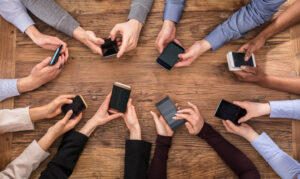
Divergent Thinking: Become a Divergent Thinker
Consider your most creative idea. Next, imagine how that idea came to be. More likely than not, it manifested from a number of possibilities prior to focusing on a single topic. There is a name for the jumbled series of miscellaneous thoughts that eventually lead to innovation. It is a thinking process called divergent thinking. Find out what is divergent thinking, elements its composed of, differences with convergent thinking, etc.

What is Divergent Thinking?
Divergent thinking is a thought process beginning with the breaking down various components of a topic to generate answers to a question. As the topic is divided into separate parts, it leads to the formation of new ideas and even new questions! The overall goal is to produce a number of possible solutions in a timely manner that could not have emerged from a more focused method of thought. Divergent thinking is unstructured, spontaneous, and non-linear—meaning individuals approach problems starting with one topic that drives many further ideas. There is no specific direction.
Elements of Divergent Thinking
Eight elements comprise the divergent thinking process:
- Risk-taking—Possessing a willingness to courageously explore, experiment, and accept new, potentially controversial ideas
- Originality—The capacity to discover ideas others have not previously thought of
- Fluency—The art of generating a variety of ideas to increase the number of solutions
- Imagination—Visualizing and thinking of original ideas
- Flexibility—An open-mindedness to accept unexpected idea combinations on a topic
- Complexity—The ability to understand and form well rounded, multifaceted ideas
- Curiosity—The yearning for knowledge to ask the appropriate questions that will guide new ideas
- Elaboration—Readiness to further ideas to experiment and build on a topic
Divergent VS. Convergent Thinking
Contrary to divergent thinking, convergent thinking is another way to confront a problem. Convergent thinking applies logic to arise at a single solution from many ideas. The process is linear, centralized around one point and does not draw from creativity. A prime example of convergent thinking is choosing an answer on a multiple-choice test. It is straightforward because there is only one right or wrong answer.
Although the two thinking processes vastly differ, divergent thinking relies on convergent thinking to arrive at a solution. Successful problem solvers confront a problem in which creative ideas are copious, yet they narrow down their chosen solution through convergent thinking.
Divergent Thinking and Creativity
While both of these concepts are undoubtedly related, the words are not synonymous. Experts define creativity as the ability to uniquely utilize original ideas to solve problems. It also involves identifying problematic aspects of a given situation (Jaarsveld & Lachmann, 2017).
Creative thinking supports innovation. The world prospers through the creativity to invent technological advances and to surmount problems at work, school, and in relationships. Still, creative thinking is not possible without its predecessor, divergent thinking. It fosters creativity because it generates those “creative” ideas. After a problem is creatively identified, divergent thinking expedites the variables of available solutions.
Activities of Divergent Thinking
Divergent thinking does not occur on its own. Frequently, it is prompted by an initial trigger to cultivate an idea and additional complex ideas stem from those. Engaging in the following activities are conducive to divergent thinking.
Brainstorming
Brainstorming is cornerstone to divergent thinking. The activity entails a lengthy, unedited list of ideas. All ideas are recorded regardless of whether or not they are deemed a worthy solution. This list format inspires new ideas from those that precede it.
Subject Mapping
As previously stated, divergent thinking is non-linear. The path from one idea to another is indirect. Think of a spider web model for planning. The main idea is in the center with separate sub-ideas branching out. Sub-ideas can also have ideas branching out (i.e. sub-sub-topics).

Journaling
Journaling is essentially a bound book of creative thoughts. Carrying a journal highlights the spontaneous aspect of divergent thinking, as an individual documents ideas as they emerge throughout the day. The journal can be reviewed later to stimulate a range of diverse ideas.
Free Writing
Free writing is similar to journaling. However, they differ in the fact that free writing is typically intentional. Structure has the tendency to impede the divergent thinking, but sitting down with the intention to write has the potential to spur the creative process. To undertake free writing, start by writing whatever comes to mind about a particular topic for a short period of time. Free writing produces collective thoughts on a subject. The key to free writing is not to stop for editing because the focus on grammatical mechanics disrupts the flow of ideas.
The SCAMPER Technique
The SCAMPER technique is a critical thinking technique designed to provide a creative thinking flow. The aim of the SCAMPER technique is to encourage free-flowing thoughts and ideas necessary for divergent thinking. SCAMPER is an acronym where each letter represents types of questions to evaluate and assess an idea.
- Substitute—What part of ideas can be substituted? The technique of substitution determines if there is a better alternative that will increase the overall gains of a solution.
- Combine—Can multiple ideas be merged? ‘Combine’ implies that two ideas can be combined to result in a new, innovative solution.
- Adapt—Should elements of an idea change for a favorable output?Flexibility is an immense factor. The ‘adapt’ technique is essential to making an idea more flexible for unexpected topic combinations.
- Modify—Can this process be viewed from a fresh perspective? Changes made during the modification stage concentrate on the solution as a whole rather than a single idea.
- Put to another use—What benefits does this idea bestow on alternative problems? Divergent thinking is innovative and creative, which demands we examine an idea from all angles—like its usefulness for other problems. Putting an idea to another use revolves around originality.
- Eliminate—What would happen if an idea were removed? Eliminating ineffective ideas is imperative to the process.
- Reverse—How can reversing the order of the initial thought process lead to a better outcome? Divergent thinking is as complex as the ideas it produces. Contemplating the sequences of the thinking process, as well as how the thinking process is altered, strengthens the usefulness of the ideas.
Divergent Thinking and the Brain
Neuroscientists have long expressed an interest in divergent thinking, which caused them to test it by measuring fMRI brain activity. Those efficient have prominent brain connections in three brain networks—the default network, the salience network, and the executive control network. The default network is especially significant, as it associated with spontaneous and imaginative cognition. Creative thinkers show increased connections in hippocampal activity on fMRI studies when asked to perform divergent thinking tasks. For example, naming creative purposes for common household objects. This lends evidence that divergent thinking is advantageous to cognitive thinking skills such as attention and memory.
Barriers to Divergent Thinking
Divergent thinking does not always transpire with ease. There is an array of emotional and mechanical barriers to the process. Overcoming the barriers are crucial for divergent thinking to be advantageous to problem solving.
- Procrastination—The most difficult step is beginning the process. While the process may occasionally be delayed for whatever reason, solutions cannot emerge without ‘jumping right in’ to it.
- Time—Speed is a major component. With the goal of one idea leading to another, it is not meant to designate much time to one thought.
- Organization—Divergent thinking is unstructured and disorganized. Focusing on organization prevents the formation of numerous ideas.
- Fear—Those wishing to become divergent thinkers need to take risks. Mistakes are unavoidable and not to be feared.
- Conformity—Conformity and fear go hand-in-hand. People fear non-conformity, afraid to stand out. However, divergent thinkers are not concerned with embracing original ideas that challenge society’s perception of normal and what is accepted.
References
Elmansy, R. (2015). A Guide to the SCAMPER Technique for Creative Thinking. Retrieved from https://www.designorate.com/a-guide-to-the-scamper-technique-for-creative-thinking/
Jaarsveld, S., & Lachmann, T. (2017). Intelligence and Creativity in Problem Solving: The Importance of Test Features in Cognition Research. Frontiers in psychology, 8, 134. doi:10.3389/fpsyg.2017.00134
Roger E.B, Yoed N.K, Alexander P.C., et al. (2018). Robust prediction of individual creative ability from brain functional connectivity. Silvia PNAS January 30, 2018 115 (5) 1087-1092; published ahead of print January 16, 2018 https://doi.org/10.1073/pnas.1713532115












